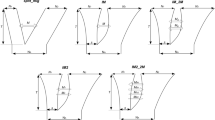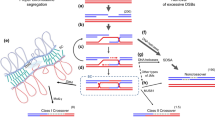Summary
Two distinct segregation patterns are recognized after G X W plastid crosses in Pelargonium. Type I parents produce offspring in which maternal zygotes are frequent, biparental intermediate, and paternal zygotes rare (MZ>BPZ>PZ), as defined by the presence or absence of green or white plastids in the young embryos into which the zygotes develop. Type II parents produce offspring in which maternal and paternal zygotes are frequent with biparental zygotes the least frequent class (MZ>BPZ<PZ).
Type I plants, which breed true, are regarded as homozygotes — Pr 1 Pr 1. Type II plants, which do not breed true, are regarded as heterozygotes — Pr 1 Pr 2. The nuclear gene is symbolized as Pr as it is presumed to control alternative patterns of plastid segregation through an effect on plastid replication.
Selfs and intercrosses of heterozygous plants segregate in an “unexpected” 1:1 ratio and not the expected 3:1 (1:2:1). The alternative homozygote — Pr 2 Pr 2 — could not be detected. Reciprocal crosses between heterozygotes (Pr 1 Pr 2) and homozygotes (Pr 1 Pr 1) give the expected 1:1 ratio when the Pr 2 allele is derived from the male, whereas there is often, but not always, a highly significant deviation from 1:1 when the Pr 2 allele is derived from the female.
A simple explanation, which is not wholly satisfactory, is to assume that Pr 2 is a gametophytic lethal on the female side. An alternative, or additional, explanation is that an incompatibility mechanism is involved in which Pr 1 is a self-compatible allele, Pr 2 a self-incompatible allele, and Pr 1-Pr 2 cross-compatible alleles. Successful fertilization is then determined by sporophytic control on the male side and gametophytic control on the female side.
Similar content being viewed by others
Literature
Abdel-Wahab, O.A.L. (1980): Genetical studies of zonal pelargoniums. Ph. D. Thesis, University College of Swansea (Wales)
Gillham, N.W. (1978): Organelle Heredity. New York: Raven Press
Hagemann, R. (1979): Genetics and molecular biology of plastids in higher plants. Stadler Symp. 11, 91–116
Kirk, J.T.O.; Tilney-Bassett, R.A.E. (1978): The Plastids: Their Chemistry, Structure, Growth and Inheritance. Amsterdam: Elsevier/North-Holland
Kubba, A.J.; Tilney-Bassett, R.A.E. (1980): The occurrence and survival of twin embryos in Pelargonium X Hortorum Bailey. Ann. Bot. 46, 113–117
Kubba, A.J.; Tilney-Bassett, R.A.E. (1981a): Genetical control of positional preference for fertilization in Pelargonium X Hortorum Bailey. Ann. Bot. 48, 221–226
Kubba, A.J.; Tilney-Bassett, R.A.E. (1981b): Genetical studies of fertilization in Pelargonium X Hortorum Bailey. Euphytica 30, 209–215
Kubba, A.J.; Tilney-Bassett, R.A.E. (1981c): Genetical control of embryo breakdown and of embryo survival in Pelargonium X Hortorum Bailey. Euphytica 30 (in press)
Lewis, D. (1979): Sexual Incompatibility in Plants. London: Edward Arnold
Linskens, H.F.; Kroh, M. (1967): Inkompatibilität der Phanerogamen. In: Encyclopedia of Plant Physiology, vol. 18 (ed. Ruhland, W.), pp. 506–530. Berlin, Heidelberg, New York: Springer
Nettancourt, D. de (1977): Incompatibility in Angiosperms. Berlin, Heidelberg, New York: Springer
Sears, B.B. (1980): Elimination of plastids during spermatogenesis and fertilization in the plant kingdom. Plasmid 4, 233–255
Tilney-Bassett, R.A.E. (1973): The control of plastid inheritance in Pelargonium II. Heredity 30, 1–13
Tilney-Bassett, R.A.E. (1974): The control of plastid inheritance in Pelargonium III. Heredity 33, 353–360
Tilney-Bassett, R.A.E. (1975): Genetics of variegated plants. In: Genetics and Biogenesis of Mitochondria and Chloroplasts (eds. Birky, C.W. Jr.; Perlman, P.S.; Byers, T.J.), pp. 268–308. Columbus: Ohio State University Press
Tilney-Bassett, R.A.E. (1976): The control of plastid inheritance in Pelargonium IV. Heredity 37, 95–107
Tilney-Bassett, R.A.E.; Abdel-Wahab, O.A.L. (1979): Maternal effects and plastid inheritance. In: Maternal Effects in Development (eds. Newth, D.R., Balls, M.), pp. 29–45. London: Cambridge Univ. Press
Tilney-Bassett, R.A.E.; Birky, C.W. Jr. (1981): The mechanism of the mixed inheritance of chloroplast genes in Pelargonium: Evidence from gene frequency distributions among the progeny of crosses. Theor. Appl. Genet. 60, 43–53.
Author information
Authors and Affiliations
Additional information
Communicated by R. Hagemann
Rights and permissions
About this article
Cite this article
Tilney-Bassett, R.A.E., Abdel-Wahab, O.A.L. Irregular segregation at the Pr locus controlling plastid inheritance in Pelargonium: gametophytic lethal or incompatibility system?. Theoret. Appl. Genetics 62, 185–191 (1982). https://doi.org/10.1007/BF00293357
Received:
Issue Date:
DOI: https://doi.org/10.1007/BF00293357




